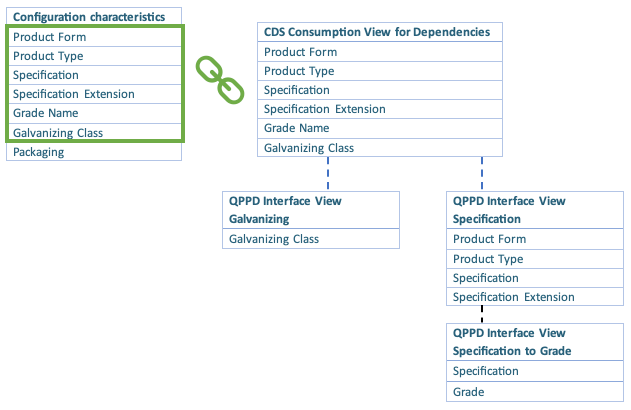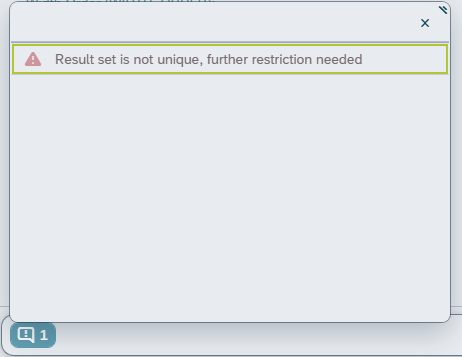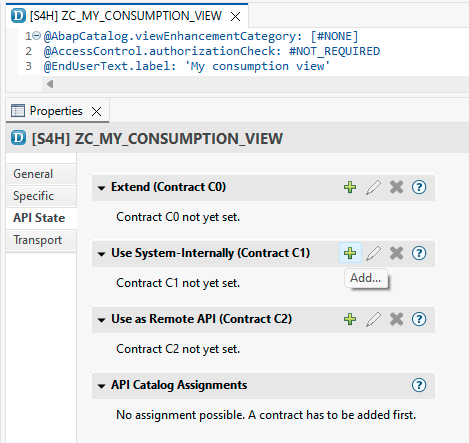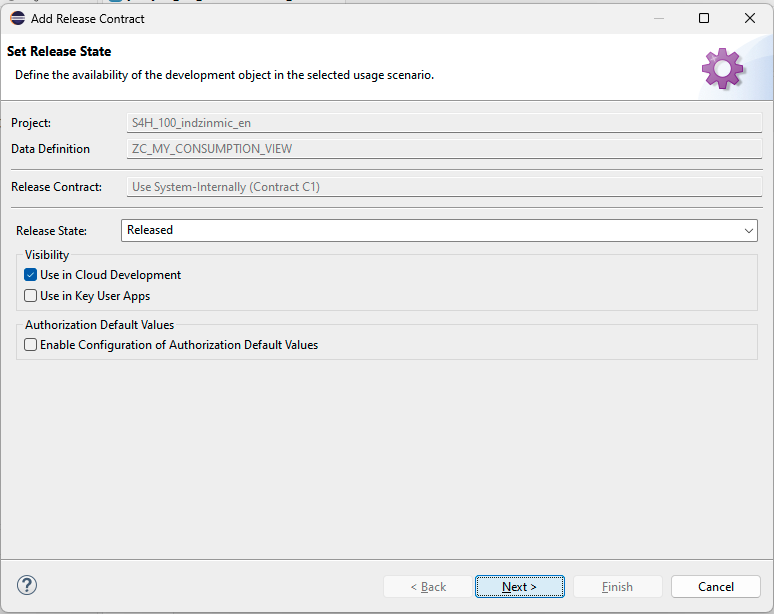CDS Views
In complex industries like steel, automotive, or machinery, configuration logic often depends on rich, interconnected master data—such as product forms, specifications, grades, coatings, and packaging. Managing such dependencies using static AVC tools like variant tables can quickly become rigid, error-prone, and disconnected from live business data.
The mdVC CDS connector solves this by linking configuration characteristics directly to CDS views. These views can represent complex dependencies from various data sources—SAP master data, QPPD models, custom logic, or even external systems—evaluated dynamically at runtime. This enables master data–driven configuration with high flexibility and no duplication of logic.
While the following example references QPPD Views, the CDS connector is fully generic. It can be used with any data source—internal or external (Custom Entity CDS View).
Why CDS Instead of AVC Logic?
AVC dependencies—especially variant tables—have several limitations:
- Manual maintenance effort
- Risk of inconsistencies
- No reuse outside of AVC
- Disconnected from actual business data
By contrast, CDS views offer:
- Full modeling flexibility (joins, enrichment, filters, semantics)
- Live access to real master data
- Reuse across applications (Fiori apps, reporting, APIs)
- Centralized, declarative business logic
Using CDS makes configuration transparent, data-driven, and scalable—a best practice for S/4HANA-based modeling.
How It Works
A configuration instance is linked to a CDS consumption view, which collects and resolves dependencies. Multiple CDS view groups can be involved (technically, this means multiple CDS tasks). Each view filters valid values or derives characteristic values at runtime.

By default, characteristics are matched to CDS view fields by name. However, field mappings can be customized when defining the task. The CDS view consolidates data from various sources and exposes valid combinations to the configuration process.
Behavior and Scope
The CDS connector task executes the following logic:
- Restrict value help based on current characteristic values
(e.g. only certain packaging types are valid for "Sea" transport) - Auto-determine values when only one valid option remains
info
Determination only applies if the user hasn’t already entered a value.
- Set characteristics to read-only when only one valid value exists
- Validate uniqueness: the current combination of values must match exactly one CDS row. Otherwise, an error is raised.
This ensures that configuration stays consistent with the actual business logic modeled in master data.
Example with Data
Configuration Instance (User Input)
| Characteristic | Value |
|---|---|
| Product Form | COIL |
| Product Type | CR |
| Specification | |
| Specification Extension | |
| Grade Name | |
| Galvanizing Class | |
| Packaging |
CDS Consumption View
The following table shows all available combinations. Rows not matching the user input (e.g. invalid product type/form) are excluded from evaluation.
| Product Form | Product Type | Specification | Specification Extension | Grade Name | Galvanizing Class |
|---|---|---|---|---|---|
| COIL | CR | EN10130:2006 | DC01 | No | |
| COIL | CR | EN10204 | 4711 | DC01 | No |
| COIL | CR | EN10204 | DC03 | No | |
| COIL | HDC | EN10168 | DC05 | A | |
| SHEET | HR | EN10204 | DC03 | C | |
| PLATE | HR | EN10168 | DC03 | B |
Configuration After CDS Evaluation
With only one matching value for Galvanizing Class, it is determined automatically:
| Characteristic | Value |
|---|---|
| Product Form | COIL |
| Product Type | CR |
| Specification | |
| Specification Extension | |
| Grade Name | |
| Galvanizing Class | No |
| Packaging |
However, since more than one row remains, the configuration is still not unique, and an error is raised:

Most of the time it’s recommended to wrap the CDS connector task in a Settler Task to re-evaluate logic as values evolve dynamically.
Available Values (Value Help)
| Product Form |
|---|
| COIL |
| Product Type |
|---|
| CR |
| HDC |
| Specification |
|---|
| EN10130:2006 |
| EN10204 |
| Specification Extension |
|---|
| 4711 |
... and others ...
Task
To use the CDS connector, instantiate the task class /mxp/vcha_cl_va_cds_link and pass your CDS view name:
new /mxp/vcha_cl_va_cds_link( 'ZC_MY_CONSUMPTION_VIEW' )
By default, all characteristics with name-equal CDS fields are considered. You can optionally define:
- Field mappings (custom characteristic ↔ field name)
- Ignored fields
- Parameter definitions (e.g.,
THICKNESSas a CDS view parameterP_THICKNESS)
new /mxp/vcha_cl_va_cds_link(
i_cds_view_name = conv #( cl_abap_structdescr=>describe_by_data( value zc_my_consumption_view( ) )->get_relative_name( ) ) "in order to make where used work, get the name dynamically
i_parameter_definitions = value #(
( characteristic_name = 'THICKNESS'
cds_parameter_name = 'P_THICKNESS'
cds_parameter_null_name = 'P_THICKNESS_IS_NULL' ) ) "for integers, it may be an interesting info to check whether the value is assigned or not (null) -> boolean as CDS parameter
i_field_mappings = value #(
( characteristic_name = 'PRODUCT_TYPE'
cds_field_name = 'ProductType' )
( characteristic_name = 'PRODUCT_FORM'
cds_field_name = '' "initial means, do not respect it although it might exist ) ) ).
This task can be used standalone or embedded in a composite task. Wrapping it in a Settler Task is recommended for resolving interdependent logic.
Any CDS view used by a CDS task must be released for system-internal use to comply with clean core principles (contract C1).
In the example shown, the CDS view ZC_MY_CONSUMPTION_VIEW must be explicitly released. This ensures it can be safely consumed by the framework at runtime.
Follow the standard release process:

